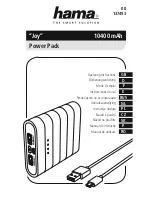
- 4 -
AL400ULX series
Installation Instructions
(cont’d)
:
2. The power supply is pre-wired to the ground (chassis). Connect main incoming ground to the provided green
grounding conductor lead. Connect unswitched AC power (115VAC / 60Hz) to the terminals marked [L, N]
(Fig. 1, pg. 3). Use 14 AWG or larger for all power connections (Battery, DC output, AC input). Use 22 AWG to
18 AWG for power-limited circuits (AC Fail/Low Battery reporting).
Keep power-limited wiring separate from non power-limited wiring (115VAC / 60Hz Input, Battery Wires).
Minimum 0.25” spacing must be provided.
CAUTION: Do not touch exposed metal parts. Shut branch circuit power before installing or servicing equipment.
There are no user serviceable parts inside. Refer installation and servicing to qualified service personnel.
For Fire Alarm applications the outputs are “Special Applications” only, see list (refer to Appendix A, pg. 6).
For other devices contact Underwriters Laboratories to ensure compatibility.
3. Set the unit to the desired DC output voltage by setting SW1 (Fig. 1c, pg. 3) to the appropriate position
(Power Supply Voltage Output Specifications Chart, pg. 2).
4. Measure output voltage before connecting any devices to ensure proper operation. Improper or high voltage will
damage these devices. When servicing the unit, AC mains should be removed.
5. Connect devices to be powered:
a. For AL400ULX Power Supply: connect devices to the terminals marked [- DC +] (Fig. 1, pg. 3).
b. For other Power Distribution Models: connect devices to be powered to the terminal pairs 1 to 4 marked
[1P & 1N] through [4P & 4N] (Fig. 2a & 2b, pg. 5) or 1 to 8 marked [1P & 1N] through [8P & 8N]
(Fig. 3a & 3b, pg. 5), carefully observing correct polarity.
6. For Access Control applications batteries are optional. When batteries are not used, a loss of AC will result in the
loss of output voltage. When the use of stand-by batteries is desired, they must be lead acid or gel type.
7. Connect appropriate signaling notification devices to AC FAIL & BAT FAIL (Fig. 1a, pg. 3) supervisory
relay outputs.
Note: When used in fire alarm, burglar alarm or access control applications, “AC Fail” relay should be
utilized to visually indicate that AC power is on. To delay report for 6 hours cut “AC Delay” jumper (Fig. 1b, pg. 3).
8. Please ensure that the cover is secured with the provided Key Lock.
Wiring:
Use 14 AWG or larger for all power connections.
Note: Take care to keep power-limited circuits separate from non power-limited wiring (115VAC, Battery).
Maintenance:
Unit should be tested at least once a year for the proper operation as follows:
Output Voltage Test: Under normal load conditions the DC output voltage should be checked for the proper voltage level
(Power Supply Voltage Output Specifications Chart, pg. 3).
Battery Test: Under normal load conditions check that the battery is fully charged, check specified voltage both at the bat-
tery terminal and at the board terminals marked [+ BAT –] to ensure that there is no break in the battery connection wires.
Note: Maximum charging current under discharges is 0.7A.
Note: Expected battery life is 5 years; however, it is recommended changing batteries in 4 years or less if needed.
LED Diagnostics:
Power Supply Board
Red (DC)
Green (AC)
Power Supply Status
ON
ON
Normal operating condition.
ON
OFF
Loss of AC. Stand-by battery supplying power.
OFF
ON
No DC output.
OFF
OFF
Loss of AC. Discharged or no stand-by battery. No DC output.
Red (Bat)
Battery Status
ON
Normal operating condition.
OFF
Battery fail/low battery.
Power Distribution Module
Green (AC)
Power Distribution Module Status
ON
Normal operating condition.
OFF
No Power Output.


























